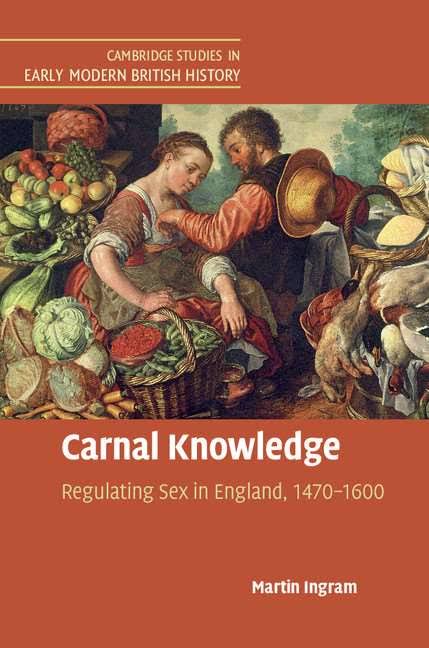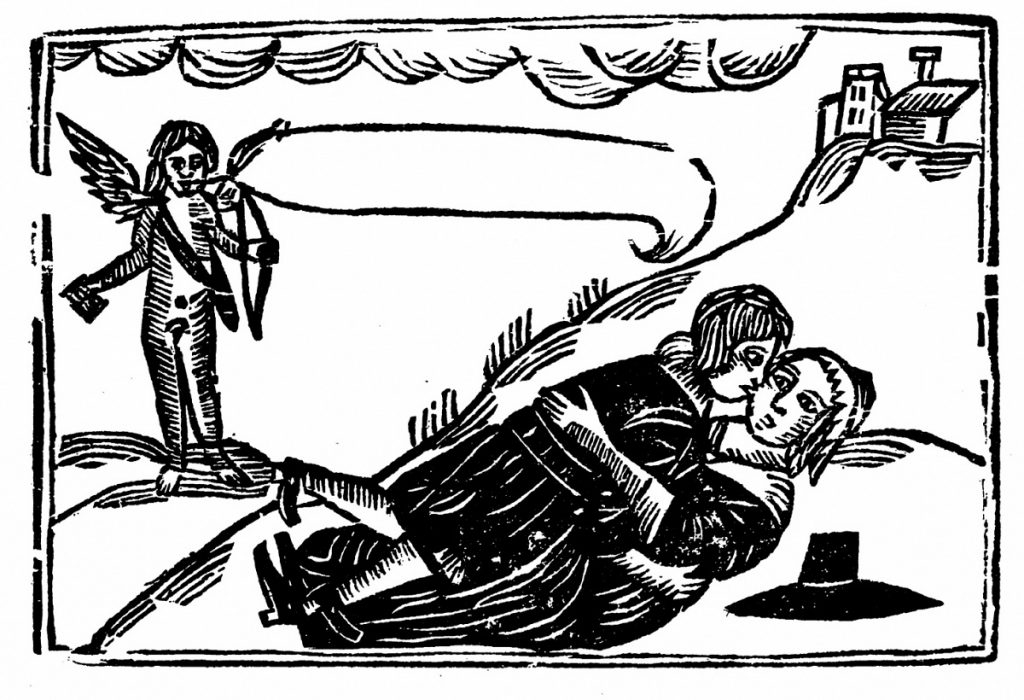Interview by Katherine Harvey
Martin Ingram’s book Carnal Knowledge: Regulating Sex in England, 1470-1600 (Cambridge University Press, 2017) explores the ways in which the law was used to control sex in late medieval and Tudor England. Considering the activities of both secular and ecclesiastical courts, it demonstrate that sexual behaviour was strictly regulated even before the Reformation: the courts concerned themselves not only with prostitution and clerical celibacy, but also with pre- and extra-marital sexual activities of the wider population. The religious upheavals of the decades after 1530 tightened the regime further, with shaming punishments and public penance becoming increasingly important. Overall, Ingram argues, there was a marked shift in England’s moral climate between 1470 and 1600.

Katherine Harvey: Why did late medieval and early modern authorities want to regulate sexual behaviour, and how did they do so?
Martin Ingram: At least since the Fourth Lateran Council of 1215 the church (supported by the crown) had striven to educate lay people not only in Christian belief and observances but also in Christian morality as it was then understood. All sexual activity outside marriage was forbidden. Secular authorities in towns and cities (London above all) were also concerned. They saw illicit sex not only as a potential threat to public order but also as an affront to Christian society and a ‘reproach’ on the reputation of the town. In the late fifteenth century, churchmen and urban magistrates can sometimes be seen in a kind of ‘virtuous competition’, striving to outdo each other in raising moral standards.
They looked to the courts to implement ‘reformation of manners’. Sexual matters were so much part of ecclesiastical court business that they were popularly known as the ‘bawdy courts’. Local manor courts, borough and city courts also lent a hand. The Reformation shook things up. Some people wanted drastic reform of the church courts and a greater role for the secular arm. More radical puritans wanted to replace the existing church courts with locally-based consistories. There were some changes, but from a European perspective the most striking thing is that the English church courts survived the Reformation in much like their traditional form.
KH: You make clear that sexual regulation was not just a ‘top down’ process. So what role did the people play in making this system work, and why were they willing to do so?
MI: All legal proceedings were deeply embedded in local social relations. Many transgressions were dealt with informally and most people used the courts only as a last resort. It was possible for the authorities to use legal sanctions to nudge people into different patterns of behaviour, but to do so they had to convince the more influential sections of local society. In fact such people did not need much persuasion to take action against prostitutes, pimps and bawds. Adultery was also a concern locally, because it created tensions that could spill beyond households into the wider community. Premarital sex was more of a grey area. Many people felt that courting couples should be left unmolested if they were ultimately heading for marriage. However, even on this issue attitudes were beginning to harden by the end of the sixteenth century.
KH: I was going to ask which offences the authorities were most concerned with, but that partly answers the question. Are there any offences which were punished less often than we might expect?
MI: The authorities and ordinary people alike were most concerned by offences that struck them as both immoral and disorderly. If they also had serious financial consequences – as in the case of bastard-bearing – this reinforced hostility. In the eyes of the church the most heinous sexual sin was the ‘unnatural’ vice of sodomy. Henry VIII’s act against buggery (1534) suggests that by this time the secular authorities thought the same. But it is very striking that sodomy was not prosecuted very often, either before the 1534 act or long after it. Ordinary people’s ideas about illicit sex centred on marriage, household and procreation – same-sex contacts were peripheral to this vision.
KH: Other than the immediate punishments meted out by the authorities, what were the consequences for an individual found to have committed a sexual offence?
MI: There was an extraordinary range of official penalties. The church courts used penance, a shame punishment that involved wearing penitential garments (shirt, smock, or a white sheet) and confessing the offence publicly. The humiliation was even greater if the penance was ordered to take place in the marketplace instead of in church. But better-off people were often allowed to commute penances into a money payment.
Fines were probably the most common penalty imposed in pre-Reformation towns, but in the 1560s and 1570s urban magistrates became harsher. Many places introduced a penalty called ‘carting’ – offenders were trundled round the town in full view of the populace. London set up Bridewell Hospital to deal with the ‘idle poor’, deemed to include sexual offenders. Most of the culprits were imprisoned for short periods and whipped. An act of parliament of 1576 authorized justices of the peace to make orders for the maintenance of bastards and to subject the parents to corporal punishment.
Locally suspects were the target of gossip and verbal abuse. Often the shame of punishment was enduring – offenders forfeited their ‘credit’, which could lead to loss of livelihood. Sometimes people had to leave their communities. Here we come full circle, because expulsion was another official penalty deployed by the authorities, especially in towns.

KH: We tend to assume that, in societies where sexual behaviour is strictly regulated, women will bear the brunt of that regulation, and the associated stigma. Was that the case in late medieval/ early modern England, or were men equally vulnerable?
MI: To an extent a double standard did operate. Sexual reputation was more central to women’s character and most people regarded female sexual transgressions as more reprehensible than those of men. That said, both the church and secular courts went after men as well as women; indeed some courts targeted men particularly. The thinking was that they were more rational than women and, if they were heads of households, carried the greater responsibility.
KH: How did the authorities deal with people who sought to profit from sexual sin, such as prostitutes?
MI: In medieval Southwark there was a string of licensed brothels called the ‘stews’, which at first sight suggests toleration. But this is belied by the determined efforts of church and secular courts, supported by local opinion, to combat prostitution on a day-to-day basis. In 1546 the stews were abolished. Long before this the city of London mounted periodic purges against ‘bawds and whores’, and in the later sixteenth century such people were among the main targets of the governors of Bridewell. But of course, there was an insistent demand for sexual services, not least from visiting ambassadors and their retinues. Then as now, the sex trade could not be eliminated.
KH: Before the Reformation, priests were supposed to remain celibate. How did society view priests who committed sexual offences, and how were they punished?
MI: Generations of Protestants assumed that rampant clerical immorality fuelled anticlericalism and helped to cause the Reformation. More recent historians have dismissed these views, but my work suggests that the revisionist pendulum has swung too far. The minority of immoral priests caused a lot of resentment. Admittedly the authorities took firm action when they could. Blatantly immoral priests were sometimes made to do penance. More often, scandal was avoided by moving them to other parishes. Nonetheless there remained a widespread feeling that the church looked after its own.
KH: The book covers a period during which England underwent dramatic religious change. How far did the Reformation change attitudes to sexual offences, and the ways in which they were managed?
MI: Some people still assume that the legal regulation of sexual behaviour was basically a post-Reformation phenomenon. This is clearly wrong, but the pattern of regulation was inflected by sixteenth-century religious debates. Some of the Reformers’ most extreme demands, such as death for adultery, were resisted, but there were some moves towards harsher treatment of sexual offenders. But changes were not all one way. Debates about which courts should deal with sexual transgressions and what penalties should be used led to clearer rules of evidence and sharper lines of demarcation between different jurisdictions. In the long run these changes helped to mitigate the impact of sexual regulation.
KH: How did attitudes to sex interact with concerns about poverty? Were the poor more vulnerable to punishment for sexual offences?
MI: One reason why the impact of the Reformation is hard to gauge is that other changes were occurring at the same time. In the late sixteenth century, population pressure and growing poverty contributed to increasing hostility to illegitimacy and, more generally, sharpened attitudes to premarital sex. But always sexual transgression had been associated with poverty and waste. Pimps and prostitutes were conventionally seen as parasites. However, the wealthy and well-connected tended to assume that sexual regulation should work like sumptuary legislation – one law for the rich and another for the poor. Religious and social changes in the sixteenth and early seventeenth centuries made this view increasingly hard to defend, but it was only slowly eroded.
KH: There seem to be some obvious similarities between the system examined in your book and, for example, Shari’a law in certain contemporary Islamic countries. Do you think such comparisons can teach us anything about the past and/ or the present?
MI: This is a tricky issue, because the draconian penalties sometimes imposed by modern states or groups such as IS do not necessarily reflect how Shari’a law operated in the past. That said, we have to recognize that harsh public punishments for sexual transgressions were very much a feature of English society in this period. Protestant zeal helped to trigger a terrifying campaign against sexual vice in mid-sixteenth century London – England’s Taliban moment, perhaps?
 Martin Ingram is an Emeritus Fellow in History at Brasenose College, University of Oxford. His publications include Church Courts, Sex and Marriage in England, 1570-1640 (1987) as well as numerous articles on sex and marriage, crime and the law, slander and defamation, scolding women, ‘rough music’ and related topics.
Martin Ingram is an Emeritus Fellow in History at Brasenose College, University of Oxford. His publications include Church Courts, Sex and Marriage in England, 1570-1640 (1987) as well as numerous articles on sex and marriage, crime and the law, slander and defamation, scolding women, ‘rough music’ and related topics.
 Katherine Harvey is a Research Fellow at Birkbeck, University of London. She is the author of Episcopal Appointments in England, c. 1214- c. 1344 (Ashgate, 2014), and has published on topics including the medieval episcopate, bodies and sexual health. She is currently writing a book on the medieval episcopal body for OUP. She tweets from @keharvey2013
Katherine Harvey is a Research Fellow at Birkbeck, University of London. She is the author of Episcopal Appointments in England, c. 1214- c. 1344 (Ashgate, 2014), and has published on topics including the medieval episcopate, bodies and sexual health. She is currently writing a book on the medieval episcopal body for OUP. She tweets from @keharvey2013

NOTCHES: (re)marks on the history of sexuality is licensed under a Creative Commons Attribution-NonCommercial-NoDerivatives 4.0 International License.
Based on a work at www.notchesblog.com.
For permission to publish any NOTCHES post in whole or in part please contact the editors at NotchesBlog@gmail.com




